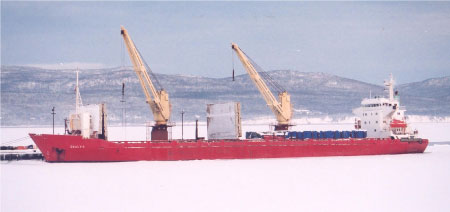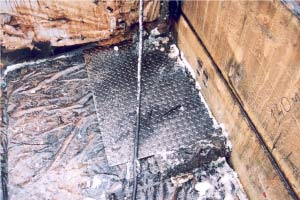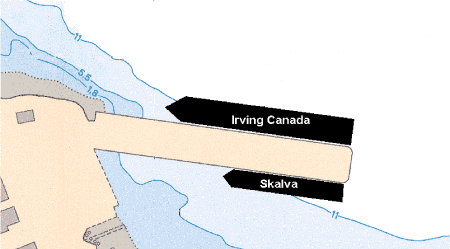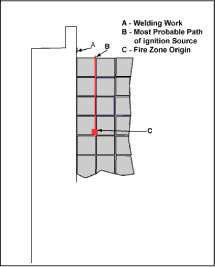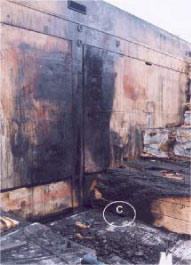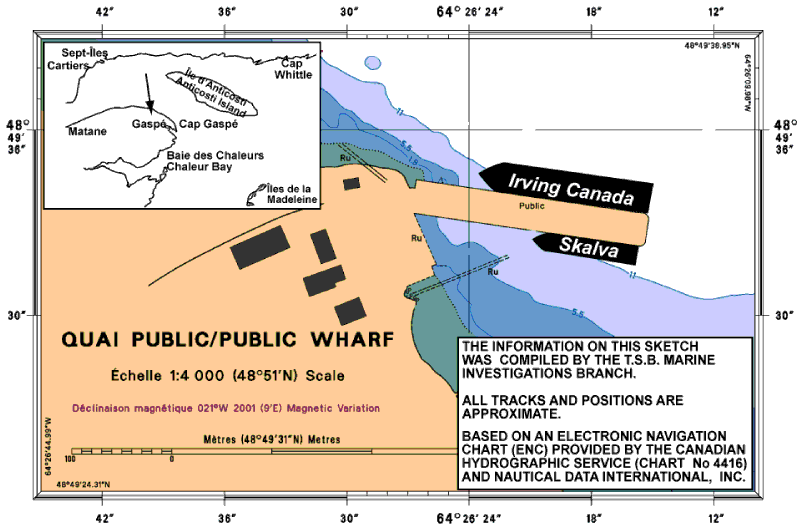Fire
General cargo ship Skalva
Gaspé, Quebec
The Transportation Safety Board of Canada (TSB) investigated this occurrence for the purpose of advancing transportation safety. It is not the function of the Board to assign fault or determine civil or criminal liability. This report is not created for use in the context of legal, disciplinary or other proceedings. See Ownership and use of content. Masculine pronouns and position titles may be used to signify all genders to comply with the Canadian Transportation Accident Investigation and Safety Board Act (S.C. 1989, c. 3).
Summary
On 04 January 2006, after the Skalva discharged a partial consignment of cargo at Gaspé, Quebec, work began on welding anchor rings for securing the remaining cargo of bundled construction lumber. During the welding process, smoke was seen rising from between the wood bundles. A dry chemical extinguisher and water were applied, but to no avail. The hatches were then closed and carbon dioxide (CO2) was released into the hold. The temperature in the hold initially increased, but then a decreasing trend was recorded. Eight days later, with the hold at ambient temperature, the hatches were opened and the fire was found extinguished. Approximately 50 bundles of lumber were damaged by the fire, of which 15 were completely destroyed. There were no injuries.
Factual information
Particulars of the vessel
| Name | "SKALVA" |
|---|---|
| IMOFootnote 1 number | 8414764 |
| Port of registry | Klaipeda , Lithuania |
| Flag | Lithuania |
| Type | General cargo |
| Gross tonnage | 5974 |
| LengthFootnote 2 | 113 m |
| Draught | Forward: 7.16 m Aft: 8.68 m |
| Built | 1984 |
| Propulsion | One Hanshin diesel engine, 4413 kW, driving a single controllable-pitch propeller |
| Cargo | Wood in bundles, lead ingots, wind farm propeller blades and equipment |
| Crew | 14 |
| Registered owner | Lietuvos Juru Laivininkystè, Klaipeda, Lithuania |
Description of the vessel
The Skalva is a small general cargo vessel with machinery spaces and accommodations located aft. The single cargo hold is serviced by two hatches and two ship's cranes.
History of the voyage
On 30 November 2005, the general cargo vessel Skalva loaded lead ingots at London, United Kingdom. At various ports in the Baltic region, bundles of kiln-dried softwood construction lumber were loaded on top of the ingots. On 16 December 2005, the Skalva departed Frederika, Denmark, bound for Gaspé, Quebec, with a load of wind-generator blades and a blade mold on top of the wood bundles.
On 03 January 2006, after unloading the blades and mold in the Port of Gaspé, the crew began re-stowing some of the wood bundles that had shifted during the ocean crossing. In order to more securely stow them, it was decided to install strapping from one side of the hold to the other. A local marine contractor was hired to grind anchor rings from their previous position and weld them further aft on the inside of the hatch coamings. This work was to be done under the supervision of the chief officer of the Skalva.
The welder placed an aluminum plate measuring 60 cm by 40 cm on the wood bundle beneath the welding area to protect the cargo (see Photo 2). Mineral wool batt insulation was used to fill void space between the bundles, and two fire hoses and a dry-chemical fire extinguisher were positioned nearby.
At approximately 1100 eastern standard timeFootnote 3 on 04 January 2006, grinding and welding of the anchor rings began on the vessel's starboard side. Once finished, the welder began work on the port side. Fire-protection measures were similar to those on the starboard side, except that no aluminum plate was used to protect the cargo. At approximately 1330, when the welding was completed, the mineral wool batt was removed and smoke was observed coming from between the cargo hold side and the first row of wood bundles, just forward of where the welding had taken place. The master was immediately informed.
Fire in the hold
The nearby dry-chemical extinguisher was immediately discharged into the void space between the wood bundle and the ship's side. Buckets of water were also used before the first fire hose was pressurized. Once pressurized, the nozzle was aimed down toward the presumed seat of the fire, but smoke continued to rise in between the wood bundles. At 1350, a second fire hose was used to direct water down through other void spaces between the wood bundles. At 1450, still unable to extinguish the fire, the master decided to close the hatches. The master then contacted the vessel owner and, following discussions, it was mutually agreed to release the vessel's fixed CO2 fire-smothering system into the hold. At 1505, 152 bottles of CO2, each weighing 45 kg, were released into the hold.
Shipboard welding procedures
The vessel had hot work procedures as part of its safety management system put in place under the International Management Code for the Safe Operation of Ships and for Pollution Prevention (International Safety Management Code or ISM Code). The procedures were generic, but included the following: tests should be carried out to ensure that combustible gases and vapours do not exceed 0.3 mg/l, and once welding work is complete, the site must be inspected and kept under observation for six hours.
The details for these procedures can be found in Appendix C, as translated from the original Russian and Lithuanian.
Alert and warning system
The vessel's agent was apprised of the situation on board the Skalva about the time the CO2 was released into the hold. At approximately 1600, he informed the inspector at the local Transport Canada (TC) Marine Safety Service Centre of the fire. Because the master had not yet informed the local Marine Communications and Traffic Services (MCTS) centre at Rivière-au-Renard, at 1627, the agent apprised the MCTS centre and then informed the Port of Gaspé harbour master. The harbour master arrived on scene soon after and conferred with the vessel's agent.
At 1631, the marine occurrence was logged by the MCTS officer and, at 1645, the details were faxed to the Alert and Warning System (AWS) officer at the MCTS centre in Québec. Between 1737 and 1756, the AWS officer faxed the details of the fire to various interested stakeholders.Footnote 4
At about 1800, the AWS officer called the ship's agent to inquire if the local fire department at Gaspé had been alerted. The agent replied in the negative, indicating that everything was under control. At approximately 1900, the AWS officer relayed this information to the TC Harbour Operations standby officer.Footnote 5 The standby officer took no further action at that time.
Emergency preparedness and response
The Port of Gaspé has procedures in place in case of emergencies. Originally drafted in 2000 and completely revised in 2004, they define the roles and responsibilities of various parties. Accordingly, the harbour master is responsible for, among other duties, informing TC Harbour Operations of the emergency and then coordinating the emergency response within the port area. The procedures also list various emergency scenarios, one of which is a fire on board a vessel. In such an event, 911 emergency services are to be called. The procedures, however, do not clearly state who is responsible for carrying out this task - mentioning a generic "observer," as opposed to a specific individual (for example, the harbour master). In this case, 911 emergency services were not called.
The city of Gaspé also has its own emergency procedures, but these do not include specific hazard analysis. Furthermore, the city's procedures do not contain accompanying standard response procedures for identified risks such as an emergency at the port.Footnote 6
During the night and morning of 04 and 05 January 2006, temperatures were monitored on board the Skalva, and rose to approximately 64°C. At 0830 on 05 January 2006, the agent called the Gaspé fire chief, not as an emergency call but rather to inform him of the situation. The fire chief immediately came to the port and, following discussions with both the harbour master and the TC inspector, the decision was made to bring in a fire crew and restrict access to the wharf. By 1200, the fire brigade had set up a command centre near the vessel.
Temperatures in the vessel's hold continued to be monitored through 06 January 2006, with the hottest point on the port side recording generally between 20°C and 27°C. The ambient exterior temperature at this time was near 0°C. On 07 January 2006, a decreasing trend in the temperature was evident with temperature recordings attaining near-ambient values by 2100 that day. The assembled team of firefighters, port authorities, and the vessel's crew began to consider the possibility of opening the hatches within the next 24 to 36 hours. The owner's representative arrived in Gaspé late on 07 January 2006 and advised against this action. Based on his experience with previous cargo hold fires, he suggested that more time be given to ensure that the fire was completely out, and that additional CO2 be made available for use in the event that the fire was re-kindled after opening the hatches.
By 11 January 2006, a truck carrying CO2 was alongside and connected to the vessel's fixed smothering system. Cargo hold temperatures had returned to ambient for the past four days. After consulting with the emergency response team, including the harbour master, the TC inspector, the TC Harbour Operations standby officer, and the Gaspé fire chief, the master, under advice from the owner's representative, decided that the hatches would be opened the next day. On 12 January 2006, the hatches were opened and the fire was found extinguished.
Hot work permit, fire risk assessment, and risk-reduction measures
As in many ports, before hot work can begin, a hot work permit must first be obtained from port authorities. The hot work permit for the Port of Gaspé is a pro-forma document stipulating that all work must be performed in strict compliance with all current fire codes, standards, and safe practices including, but not limited, to
- the Public Harbours Regulations;
- the Government Wharves Regulations;
- the Canada Labour Code;
- CAN/CSA W117.2-M87, Safety in Welding, Cutting, and Applied Processes;
- the Boiler, Pressure Vessel, and Compressed Gas Regulations;
- the Occupational Health and Safety Act;
- the Canada Confined Spaces Regulations;
- the Workplace Hazardous Materials Information System Regulation; and
- the Canadian Environmental Protection Act.
The Port of Gaspé harbour master had signed such a permit for the Skalva, as had the foreman of the company hired to carry out the welding. The hot work permit allowed welding to be undertaken on 04 January 2006 from 1000 to 1700. The Safety in Welding, Cutting, and Applied Processes standard lists fire-prevention and protection measures that must be taken. These include: using appropriate guarding to confine heat, spills, and slag so as to protect adjacent immovable fire hazards; adequately protecting all void spaces and floor openings to prevent sparks or hot slag from igniting combustible materials in adjacent areas; and maintaining a dedicated fire watch when cutting or welding is done near flammable material. The welder did not have a working knowledge of the Safety in Welding, Cutting, and Applied Processes standard. A fire hose and dry-chemical fire extinguisher were placed nearby before the start of welding work, but there is no indication that a detailed risk assessment was undertaken before cutting and welding was started - either by the ship's crew, the harbour master, the marine contractor foreman, or the welder. No dedicated fire watch was maintained.
Arrival of a tanker loaded with gasoline and diesel products
During the cooling-off period of 04 to 11 January 2006, with cargo hatches closed following the CO2 discharge into the hold, the tanker Irving Canada arrived at the port to discharge a cargo of gasoline and diesel products. On 06 January 2006, the tanker Irving Canada requested to tie up to the north side of the public wharf, 35 m from the Skalva on the south side, but the request was refused by TC Harbour Operations in consultation with TC Marine Safety.
As the temperature in the Skalva's cargo hold declined and approached ambient levels, a reassessment was done. On 09 January 2006, after having received a written opinion from TC Marine Safety that the risks were acceptable as long as certain conditions were respected, TC Harbour Operations allowed the tanker Irving Canada to dock on the other side of the wharf and discharge a cargo of gasoline and diesel.Footnote 7
Analysis
Forensic investigation
When the hold was opened after the fire, an assessment showed that the wood bundles in the vicinity of the welding work had been destroyed by a smoldering, slow-burning yet intense fire. Burn patterns indicated that the fire originated from beneath the top bundles and inboard from the first row of bundles along the port side. Bundles were systematically lifted out of the cargo hold in an effort to determine the seat and cause of the fire. After four tiers of bundles were removed, burn patterns suggested that the seat of the fire had been near the gap between the first and second rows on the port side, four tiers down from the top (see Figure 2 and Photo 3). Carbonized wood and ashes were examined in that vicinity, but no indications were found as to the source of ignition.
Before the cargo was disturbed, cigarette butts and an empty cigarette package were found on top of the wood bundles near amidships. Smoking was forbidden in the hold.
Ignition sources were present within the hold of the Skalva, which had been loaded with a combustible cargo of dry softwood lumber. The void space between the bundles that were inboard of the first row and adjacent to the hatch coaming was not blocked, and fire-retardant blankets were not used to cover the bulk wood cargo nearby. Both smoking and welding in the hold considerably increased the risk of fire. However, given the sequence of events, the proximity of the welding work to the fire zone origin, as well as the zone's depth (four bundle tiers down), there is a high probability that hot welding by-products ignited the fire.
Hot work permit and assessing fire risks
Whenever hot work such as cutting or welding is performed on board a ship, it introduces fire hazards to the surrounding areas. Good shipboard practices and many port procedures, such as those at Gaspé, call for a hot work permit to be issued before the start of such work. Typically, a permit provides a step-by-step checklist for hot work fire-prevention responsibilities and procedures before, during, and after such work is conducted. An assessment of the fire risks is carried out in advance, and appropriate steps are taken to minimize those risks before the hot work begins.
Although the Port of Gaspé issues hot work permits, these are issued solely as an acknowledgement that the relevant port official is aware that the work is being carried out and that the operation does not pose an unacceptable risk to other activities scheduled at or near the port facility. The actual assessment of the fire risks on the particular vessel requesting the permit is left to the contracting parties, such as the master and/or contractor. Some larger Canadian ports, such as the Port of Montréal, Quebec, ensure that an assessment of each work site is undertaken by fire-prevention specialists employed by the port before the issuance of any permit.
Under the ISM Code, the Skalva had a procedure for reducing risks whenever welding work was being undertaken. Although well-intentioned, this procedure was quite general and did not provide comprehensive guidance. Consequently, risks associated with welding were not fully assessed, and instituted safety measures were inadequate.
Without the benefit of a comprehensive risk assessment, the hazards associated with hot work may go unnoticed and fire-prevention measures may be inadequate. In this occurrence, the guarding used to confine the spills and slag and protect the wood cargo was insufficient. Additionally, no dedicated fire watch was maintained.
Although it is not the practice at the Port of Gaspé to use the services of fire-prevention specialists before issuing a hot work permit, fire-risk assessment by a competent specialist could help mitigate some of the risk. Furthermore, the vessel's hot work procedures did not fully achieve the intended aim, that of reducing risk when welding work is being undertaken. To be effective, procedures must be specific and comprehensive.
Port and city emergency procedures and response
In this occurrence, both the city and the port had emergency procedures in place at the time of the fire. Although the city's emergency response plan contains detailed information on managing emergencies, no specific risk analysis or corresponding standard response scenarios have been established for an emergency at the port, nor for any other specific emergency. In some instances, a city service such as the fire department may be needed at the port for an on board emergency. It is also conceivable that an emergency at the port could affect the nearby city of Gaspé, subjecting the population to undue risk. For these reasons, the port ought to be included as an area of interest for a specific risk analysis in the city's emergency response plan.
On the other hand, the port's emergency procedures contain various scenarios and specifically list the city's fire department as an agency to call in the event of a vessel fire. However, with no specific person allocated to this task - the scenarios mention only a generic "observer" - it was not until some 19 hours after the Skalva fire was discovered that the city's fire department was informed.
In 1997, following an explosion and fire on board the petroleum tanker Petrolab at St. Barbe, Newfoundland, improved emergency preparedness at local ports was called for.Footnote 8 In 1998, the vessel Southgate suffered a fire in the hold while at the Port of Grande-Anse, Quebec.Footnote 9 Not only were the local municipal firefighters needed, but firefighters from a nearby military base were also called for support.
Several lessons were learned following the Southgate fire, including the need to inform local fire departments of developing situations in a timely manner. The Port of Gaspé response plan could benefit from these lessons learned. In this instance, the harbour master did not call 911 or TC Harbour Operations, and a detailed assessment of the risks posed to the harbour or the community was not carried out during the alert phase of the emergency.
Essential, safety-critical, and value-added communications were left to third parties such as the vessel's agent, whose principal interests rest with the vessel and not with the port. Additionally, port and city emergency plans and procedures were neither integrated nor co-referenced. Without an integrated approach, emergency response may be less than optimal. Periodically conducting simulated exercises would provide an opportunity to identify and address shortcomings identified in this investigation.
Alert and Warning System (AWS)Footnote 10
In this occurrence, the local TC inspector was alerted by the ship's agent some 2.5 hours after the fire was discovered; it took another 30 minutes before the MCTS was alerted. Although the MCTS informed the AWS officer in a timely manner, the interested stakeholders - contrary to accepted procedures - were not promptly notified by telephone but were sent the information by fax. Since this was done near the close of normal business hours, several interested stakeholders only became aware of the fire on the Skalva the following morning. Only the TC Harbour Operations standby officer was called by the MCTS, belatedly, at about 1900 on 04 January 2006. The quality and the lack of urgency of the now-second-hand information given at this time induced the officer to take no further action.
In the first instance, all the initial communications were done by the ship's agent when he became aware of the fire on board the Skalva. The master did not initiate communication with the MCTS when the fire was discovered, nor did the harbour master communicate with the TC Harbour Operations standby officer upon becoming aware of the fire at approximately 1630 (in order to give first-hand, value-added information as was required by the port's emergency procedures). Finally, the local firefighter brigade was not called until 0830 the next morning.
The importance of timely accident reporting has been underlined in the past,Footnote 11 and information at hand suggests that, at almost every step of the alert and warning process, the system broke down or did not function in an optimal manner. The interested stakeholders were not readily alerted, although the consequences in this instance do not appear to have been aggravated by this oversight.
CO2 smothering
For the fire on the Southgate, the hatches, which had been closed ahead of the release of CO2, were re-opened within 24 hours, at which point the fire subsequently re-ignited. This was also noted in the case of the wood-pulp fire on board the VaasaborgM in 2001.Footnote 12
In the case of the Skalva, if not for the advice of the vessel owner's representative, who had experienced the Southgate fire, the hatches may have been opened on 08 January 2006 without the presence of a backup supply of CO2. Temperature monitoring, as was done in this case, is only one element in the decision-making process to open (or not) the hatches. Time is another critical factor, particularly as temperature readings may be erroneous when carried out at a distance from the seat of the fire. Readings may be affected by cargo and the ship's structure.
Given the mass of cargo involved on a typical vessel and the permeability of a stow (such as bundles of wood or other break bulk commodities), past experiences demonstrate that a minimum period in excess of a few days may be necessary to ensure that cargo does not re ignite. In this instance, sufficient time was allowed before opening the hatches.
Findings
Findings as to causes and contributing factors
- Welding was undertaken in the hold of the Skalva without adequate precautions or protection for the cargo of dry softwood construction lumber.
- Given the sequence of events, the proximity of the welding work to the fire zone origin, as well as the zone's depth (four bundle tiers down), there is a high probability that hot welding by-products ignited the fire.
Findings as to risk
- In small Canadian ports, fire-prevention specialists do not always undertake an independent assessment of each work site before a hot work permit is issued for a particular vessel, placing vessels and ports at undue risk.
- Information concerning the fire on the Skalva was slow to reach all interested stakeholders and precluded a timely and coordinated response.
- When port and city emergency plans and procedures are not integrated or co-referenced, emergency response may be improvised and less than optimal.
- Without comprehensive, task-specific procedures that give adequate guidance, the intended aim of a safety management system pursuant to the International Management Code for the Safe Operation of Ships and for Pollution Prevention (ISM Code) (that is, reducing risks and making ship operations safer) cannot be fully realized.
Other findings
- The arrival and cargo discharge of the Irving Canada was delayed until such time as the risks were considered acceptable and additional conditions were imposed on both vessels to permit safe operation.
- Permitting air to prematurely enter a cargo hold following a fire negates the smothering action of the carbon dioxide (CO2) and can lead to re-ignition. In this occurrence, sufficient time was allowed before the hatches were opened so as to avoid this.
- The role assumed by the harbour master during the critical alert and warning period did not follow established procedures and best practices.
Safety action
Safety action taken
On 05 April 2006, the TSB issued Marine Safety Advisory (MSA) 05/06, Adequacy of the Assessment of Fire Risks Associated with Hot Work Undertaken in Canadian Ports, addressed to the Director General, Airport and Port Programs, at Transport Canada (TC).
TC responded to MSA 05/06 by stating that port officials issue hot work permits, not to comment on the safety of a particular operation but rather with a view to ensuring that such hot work does not pose an unacceptable risk to other activities at or near the port. TC further stated that specific risk assessments on board each vessel are left to trained professionals - without being specific as to whom these trained professionals might be. The issuing of hot work permits was, however, placed on the agenda of the Airport and Port Programs Directorate's May 2006 operations seminar and the matter was discussed.
In February 2006, Marine Communications and Traffic Services (MCTS), Canadian Coast Guard, Quebec Region, undertook an internal review with operational MCTS officers to ensure that all proper agencies dealing with this type of situation were promptly notified.
Safety concerns
Hot work
The Port of Gaspé, like many small ports in Canada, issues hot work permits as an acknowledgement that the relevant port official is aware that the work is being carried out and that the operation does not pose an unacceptable risk to other activities scheduled at or near the port facility. The actual assessment of the fire risks on the particular vessel requesting the permit is usually left to the contracting parties, such as the master and/or contractor. Typically, safety precautions are specified in checklists drafted pursuant to the vessel's safety management system. In this occurrence, while the vessel had procedures for reducing risks whenever welding work was being undertaken, they were quite general and did not provide comprehensive guidance. Furthermore, not all of the procedures were followed; for example, there was no dedicated fire watch. Some large Canadian ports, such as the Port of Montréal, Quebec, ensure that an assessment of each work site is undertaken by fire-prevention specialists employed by the port before the issuance of any permit.
Although it is not the practice at the Port of Gaspé to use the services of fire-prevention specialists before issuing a hot work permit, fire-risk assessment by a competent specialist could help mitigate risks associated with hot work on vessels. Fire-prevention specialists are employed by many municipalities and arrangements could easily be made for service sharing. Although this issue was discussed at the Airport and Port Programs Directorate's May 2006 operations seminar, no new measures are known to be forthcoming.
Although the TSB database shows that there have been two other occurrences in which hot work operations resulted in a fire,Footnote 13 the TSB notes that, internationally, hot work operations have resulted in other fires. For example, in 1998, the Liberian passenger vessel Ecstasy had departed the Port of Miami, Florida, with 2565 passengers when a fire started in the main laundry. The probable cause of fire was the unauthorized welding by crew members in the main laundry that ignited a large accumulation of lint in the ventilation - the welders did not comply with the hot work permit procedures outlined in the vessel's safety management system manual.Footnote 14 More recently, a general cargo vessel en route to the United Kingdom with a cargo of plywood in the hold was carrying out hot work operations and molten steel fell into the hold and ignited the plywood stowed below. No fire watch was established, no hot work permit was issued, and the check for flammable material in the hold was superficial.Footnote 15
Hot work is often carried out in connection with routine maintenance and repair operations while in port or at sea, and consequently, there may be a lack of attention and vigilance associated with the planning and carrying out of such work. The Board is concerned that the level of planning and the particular care that should be taken before hot work is carried out on board vessels may not be sufficient to ensure the safety of the work. The Board will continue to monitor occurrences involving hot work fires with a view to assessing the need for further safety action.
Planning and coordination of emergency plans
Within Canadian ports, the responsibility for providing an emergency response plan, including firefighting assistance for vessels in port, generally rests with the port management. These plans often rely on municipal fire departments for firefighting support and on other local emergency services. Given that risks associated with an improperly coordinated response are higher than those associated with a fully coordinated response, the identification of the risks and a planned and coordinated approach are necessary to deal with a vessel-related emergency while supporting the vessel owner's efforts to deal with occurrence. In this occurrence, both the port and the city had plans and procedures in place at the time of the fire; however, the plans and procedures were neither integrated nor co-referenced. Furthermore, no specific risk analysis had been established for an emergency at the port in the city's plan.
In 2001, the absence of an appropriate, current contingency plan for responding to vessel-related emergencies and the lack of emergency-related training of St. Lawrence Seaway Management Corporation personnel contributed to difficulties experienced in responding to a fire on board the bulk carrier Windoc.Footnote 16
The response to a major vessel-related emergency may involve various agencies and organizations, ports and municipalities, each of which requires coordination and integration within the overall response. The Board is concerned that the continuing disparities of a planned and coordinated approach to emergencies, as demonstrated in this occurrence, will continue to jeopardize the effectiveness and the safety of the response. The Board will continue to monitor the situation with a view to assessing the need for further safety action.
This report concludes the Transportation Safety Board's investigation into this occurrence. Consequently, the Board authorized the release of this report on .
Appendices
Appendix A - Sketch of the occurrence area
Appendix B - Conditions for allowing discharge of fuel cargo by the Irving Canada on 09 January 2006
The vessel Skalva must:
- Comply with oil terminal facilities' regulations and enforce a policy of no smoking, no open flames, and no hot work on exposed decks.
- Under no circumstances shall the hatches be opened before the Irving Canada leaves the berth.
- Temperature sensors within the hold must be continuously monitored, and any increase in temperatures reported to the harbour master and the Transport Canada inspector.
The vessel Irving Canada must:
- [The master must] be informed of the situation on the Skalva.
- Be ready to stop cargo discharge at any time, disconnect the cargo hoses, and leave the berth as rapidly as possible if so ordered by the harbour master.
Appendix C - Vessel procedures for welding operations
INSTRUCTIONS for complying with fire-safety regulations when conducting welding operations
[Translated from Russian]
- 1. The person responsible for fire safety and organizing/conducting welding operations is the chief engineer, or a person appointed by the captain's order.
- 2. Before starting welding operations, a metal inert gas (MIG) welder must:
- 2.1 receive a briefing from the person in charge of welding operations on the ship;
- 2.2 obtain written permission signed by the ship's captain;
- 2.3 check the work site for compliance with fire-safety regulations;
- 2.4 check for the availability of firefighting equipment at the site of welding operations;
- 2.5 if necessary, demand a fire post at the site of welding operations; and
- 2.6 before the start of welding operations on premises that were previously used for any work with flammable or combustible liquids - or in cisterns or tanks that previously contained flammable or combustible liquids - welding may begin only after testing the composition of the gas-and-air environment in the rooms, cisterns, tanks, or pipelines for the presence of combustible vapours and gases. Test results must subsequently be included in the written permit for conducting welding operations. The concentration of combustible gases and vapours should not exceed 0.3 mg/L.
- 9. One should report to the mate on watch before starting, and after completing, welding operations.
- 10. Once welding operations are completed, the site should be inspected and remain under observation for six hours.
- 11. If a fire breaks out, the MIG welder (or the first person to notice the fire) must report it immediately to the mate on watch, and then begin extinguishing the fire.
- 12. Those guilty of violating fire-safety regulations shall be held responsible.
- 13. Permits for conducting welding operations must be entered in a special regulation-format logbook.
Appendix D - Glossary
- AWS
- Alert and Warning System
- CAN/CSA
- Canadian standard
- cm
- centimetres
- CO2
- carbon dioxide
- CSA
- Canadian Standards Association
- D.C.
- District of Columbia, United States
- IMO
- International Maritime Organization
- ISM Code
- International Safety Management Code
- kg
- kilograms
- kW
- kilowatts
- m
- metres
- MCTS
- Marine Communications and Traffic Services
- mg/L
- milligrams per litre
- MIG
- metal inert gas
- MSA
- Marine Safety Advisory
- TC
- Transport Canada
- TSB
- Transportation Safety Board of Canada
- °C
- degrees Celsius
